One issue with Olympic lifts is that they take much time and skill to master. This sucks because the snatch and clean & jerk are fantastic movements with benefits that extend beyond the sport of weightlifting. That said, you can reap many of those benefits in a fraction of the time by performing the power clean, a simpler, straightforward power-building barbell exercise. Get good at power cleans and you’ll find yourself moving faster, lifting heavier weights, and performing better in and out of the gym.
How to Do the Power Clean
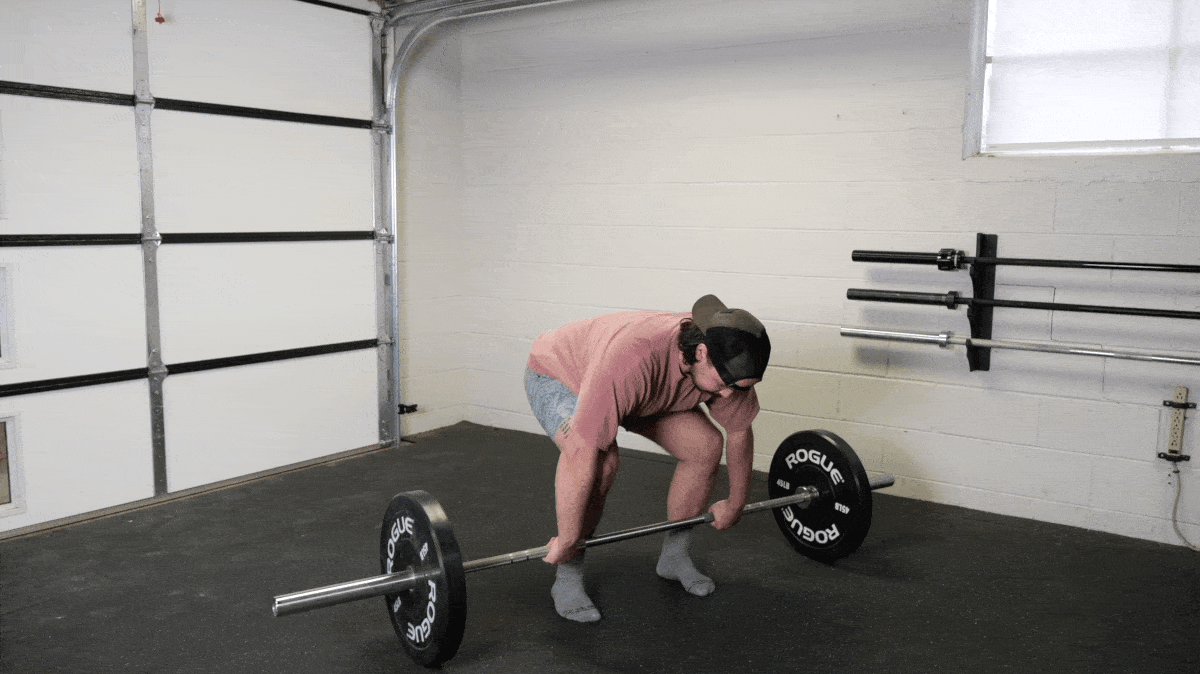
What is a power clean? In short, it’s a rapid, fluid motion during which you vault a barbell from the floor up to your shoulders using the muscular power in your legs and back. Proper power clean form is all about patience, coordination, and aggression. Here’s how to do it.
Equipment Needed: To perform a standard power clean, you’ll need a barbell, bumper plates, and the best barbell collars you can find. Access to a lifting platform is a perk, and wearing a pair of weightlifting shoes will greatly enhance your performance, though they aren’t required.
- Step 1 — Stand in front of a loaded barbell with a hip-width stance and your feet pointed out slightly. The bar should be about an inch from your shins.
- Step 2 — Squat down and grab the bar with a narrow grip just outside your shins. Flatten your back and allow your knees to creep in front of the bar. The crease of your hip should be just higher than your kneecap. Look straight forward and relax your arms.
- Step 3 — Begin the power clean by pushing down into the floor as though you were performing a leg press. Let your knees drift back naturally, but keep your shoulders over the bar as it passes your knees.
- Step 4 — Continue pushing down with your legs as the bar approaches your upper thighs. Then, swiftly extend your legs like you were going to perform a vertical jump.
- Step 5 — Allow the bar to fly freely upward. Flip your elbows around and receive the bar in the front rack position with your legs slightly bent.
Coach’s Tip: Don’t actively pull on the bar with your arms at any point. Rely on the power of your legs to drive the bar straight up and then catch it.
Power Clean Variations
Here are a couple of viable power clean variations you can also incorporate. These modifications retain the essence of the power clean but may be more comfortable to you as a beginner. There are many more ways to modify the clean than just these two, but use these as a starting point:
Hang Power Clean
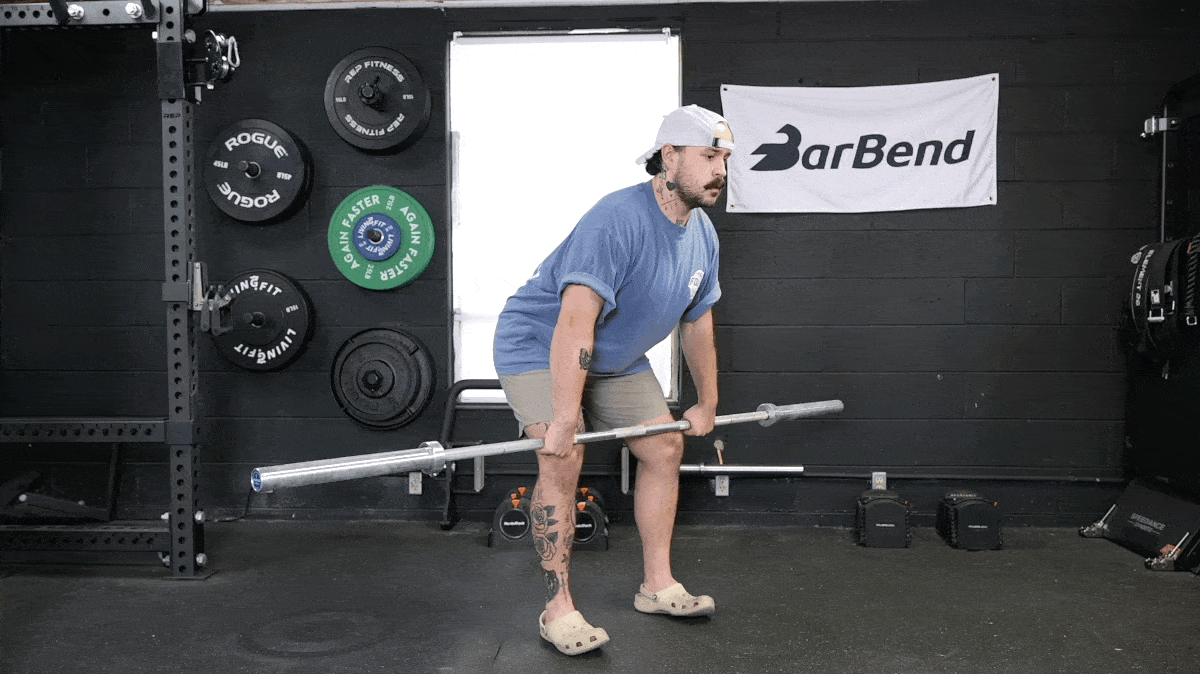
[Read More: Hang Clean Vs. Power Clean — Which Lift Should You Be Doing?]
Why Do It: Hang lifts in weightlifting are performed by starting from a standing position with the bar in hand rather than resting on the floor. By “hanging” down from a standing position, you can eliminate the beginning of the range of motion and focus more intently on extending your legs and catching the bar comfortably.
Equipment Needed: If you have the equipment for a standard power clean, you can do hang power cleans with no problem.
- Stand tall with the bar in hand and your feet under your hips. Balance your feet; don’t sit back on your heels; look straightforward.
- Hinge at the hips, deliberately tipping over and allowing your shoulders to hang in front of the bar as it glides down your thigh. Keep your back flat and your chest up.
- Once the bar reaches roughly your kneecap, reverse the motion, pushing into the floor hard and extending your body vertically in space.
- As the bar flies upward, drop down into a high squat position and catch it in the front rack.
Muscle Clean
[Read More: Muscle Clean vs Power Clean]
Why Do It: In Olympic lifting, muscle cleans are designated as such if you do not re-bend your legs to catch the bar in any squat variation. Muscle cleans are great for practicing the extension portion of the pull or as something you can incorporate during a weightlifting warm-up sequence.
Equipment Needed: An empty barbell alone is enough for the muscle clean, especially for beginners.
- Squat down while holding the barbell around mid-shin height and assume the same posture as you would if you were doing a power clean from the floor.
- Push down with your legs and come up to a standing position swiftly.
- As you stand up, pull the bar up your torso by driving your elbows high, then flip them over at the last second and deliberately place the bar in the front rack position.
Power Clean Alternatives
If you aren’t into the power clean but want to do something that improves your explosive power, try these power clean alternatives out instead:
Box Jump
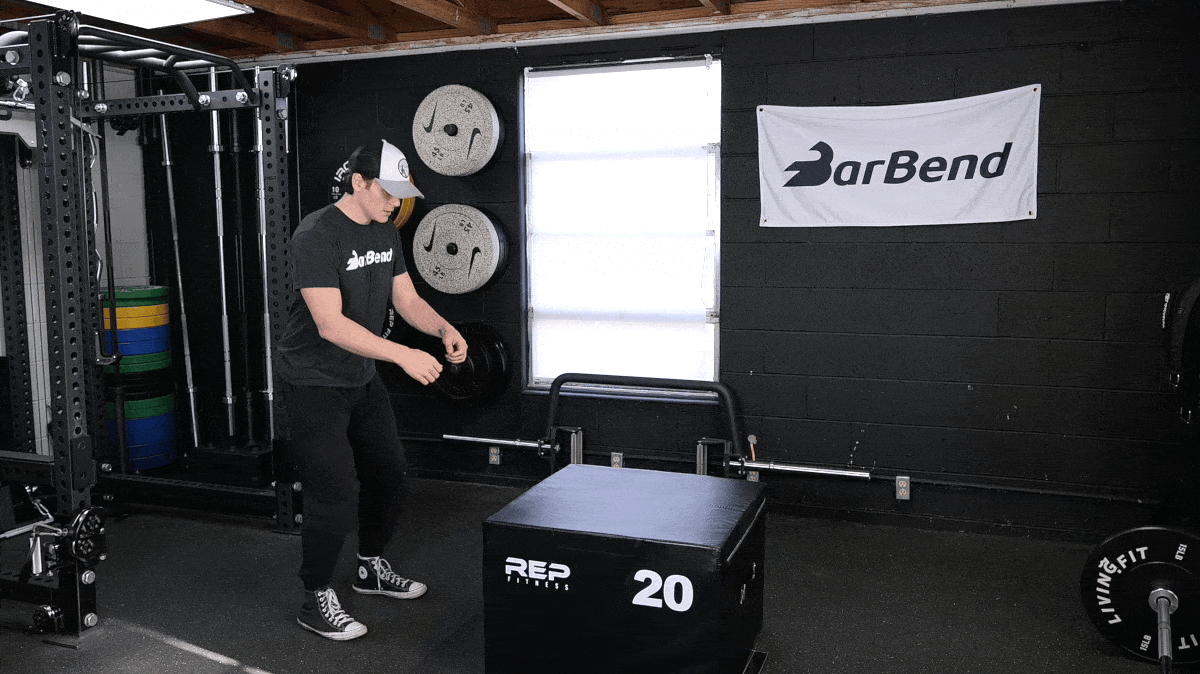
[Read More: 14 Best Box Jump Variations to Bring Your Leg Power to New Heights]
Why Do It: Box jumps require you to rapidly extend your lower body just like you would during the power clean, but you don’t need a barbell or any fancy equipment. They’re also great for getting your heart rate up and improving your conditioning without having to learn a complex technique.
Equipment Needed: You’ll need something stable to jump onto, such as a plyo box, but a weight bench will work in a pinch.
- Stand facing the box or bench a foot or two away from it.
- Sink into a partial squat position and swing your arms behind your torso.
- Then, push into the ground and leap up into the air, landing firmly on the box.
- Stabilize yourself, step back down gently, and repeat the motion.
Kettlebell Swing
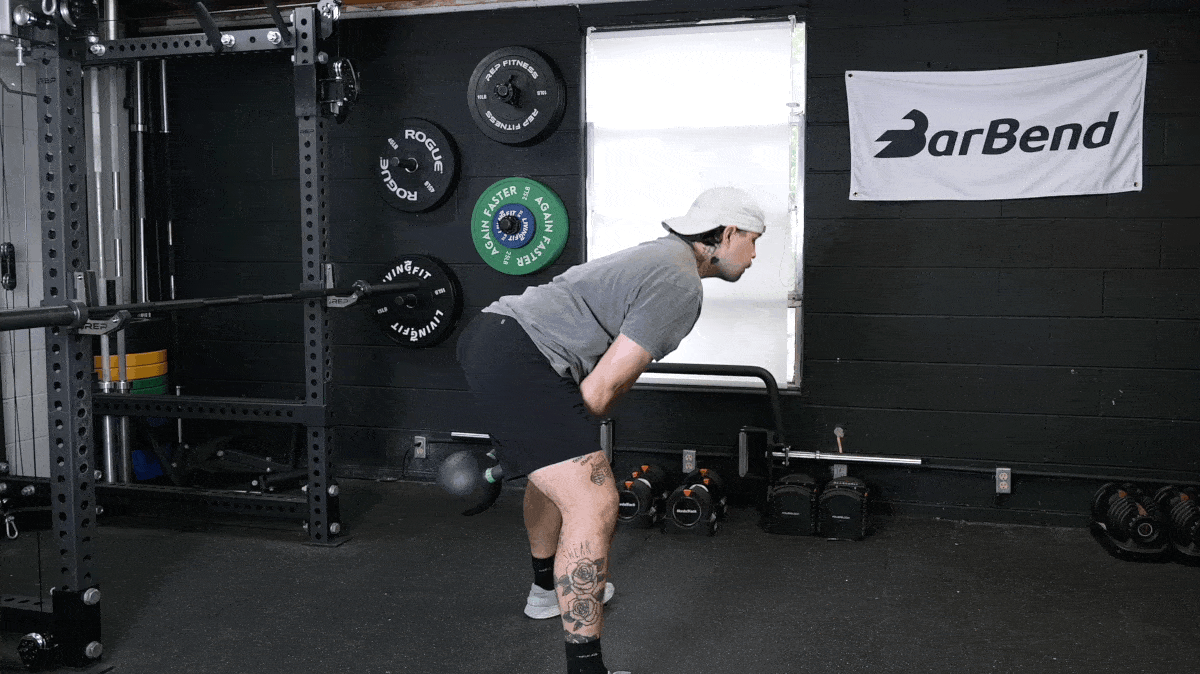
[Read More: How to Do the Kettlebell Clean]
Why Do It: Kettlebell swings teach you to extend your hips explosively but don’t have as many moving parts as the power clean. You can do swings if you want to develop lower-body coordination and power but don’t have the time to learn the power clean from scratch.
Equipment Needed: You’ll need an assortment of different kettlebells. As you increase your strength, you’ll want to have some pretty heavy weights to swing.
- Stand up with a moderate to wide stance (think around shoulder width or even winder) while holding a kettlebell by the handle, arms down in front of your body.
- Hinge at the hips and tip over, allowing the bell to swing back between your legs.
- Extend your hips to “kick” the bell out and upward while keeping your arms relaxed.
- As the bell arcs back down between your legs, sink into another hinge and repeat the motion without stopping.
Who Should Do Power Cleans
The power clean is a weightlifting (as in, the Olympic sport) accessory exercise. But it is commonly used for a wide variety of other purposes. Here are a few groups that regularly perform power cleans — if you fall into any of these camps, the movement might just be right for you.
Olympic Lifters
Learning the power clean is often a precursor to performing the complete clean & jerk, one of the two competitive movements of the sport of Olympic lifting. Think of it as a stepping stone. If you want to do a 1-rep max clean & jerk, you need to learn the fundamentals first, and the power clean is a great way to get your feet wet.
Athletes
Whether you perform on the track, field, court, pool, rink, or any other area of play, if you’re an athlete you should consider adding power cleans into your repertoire. They are unparalleled for teaching you to rapidly contract your lower body against resistance, which replicates many common sporting motions — think an offensive lineman in football, breaking into a sprint on the track, or jumping up to dunk a basketball.
Cross-Trainers
You’ll commonly find power cleans and their variations in functional fitness programs like CrossFit. This is because the power clean challenges multiple dimensions of athleticism at once.
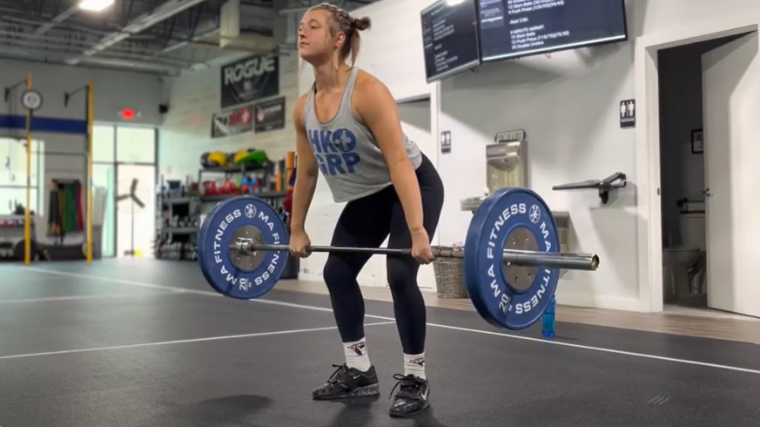
[Read More: How Much Should You Clean In Relationship To Your Front Squat]
“Barbell cycling” is an important skill to master if you want to do well during metcons or timed events; rate of force development is integral for strength training no matter your goals; several sets of power cleans back-to-back will challenge your cardiovascular capacity … the list goes on.
Power Clean Sets & Reps
If you’ve decided you want to start doing power cleans, you’ll also need to know how to program them to reach your goals. Here are a few different ways you can apply the power clean to your next full-body workout or Olympic lifting practice session:
- As a Beginner: Keep it simple. Do 5 to 8 sets of up to 3 power cleans with the empty bar or very light weights to practice your technique.
- For Strength: Try 5 sets of 2 power cleans with a moderate-to-heavy load.
- For Sports: Do 3 to 5 sets of 5 power cleans with a light-to-medium weight, focusing on explosiveness and speed.
Benefits of the Power Clean
Whether you’re a CrossFit athlete, looking to improve your Olympic weightlifting, or are a general gym-goer who wants to be a bit more powerful — here are three benefits from doing the power clean.
Build and Test Muscular Power
Even if you aren’t an Olympic lifter, you can benefit from the power clean. Power cleans are commonly used in athletic settings to improve speed, coordination, and power output from the high school to professional levels. In fact, studies even show that the power clean is one of the best ways to assess your potential power output. (1)
Great for Strength
The power clean may be explosive, but it’s still a strength-building tool. The faster you can move a weight, the more adept and prepared your body and mind will be to grind out during a heavy 1-rep max squat or deadlift. In clinical settings, researchers often regard power cleans as one of the best overall tools for measuring total-body strength and coordination. (2)
Better Olympic Lifts
The power clean is essentially the first third of the clean & jerk. If you’re a competitive weightlifter, then your initial pull from the floor during the standard clean & jerk will get stronger.
Improved Clean Technique
The power clean can help lifters who fail to reach full extension in the clean and/or do not finish the pull with aggression. By not allowing the lifter to move into the full front squat, you force them to produce more power and secure the load in the higher squat position.
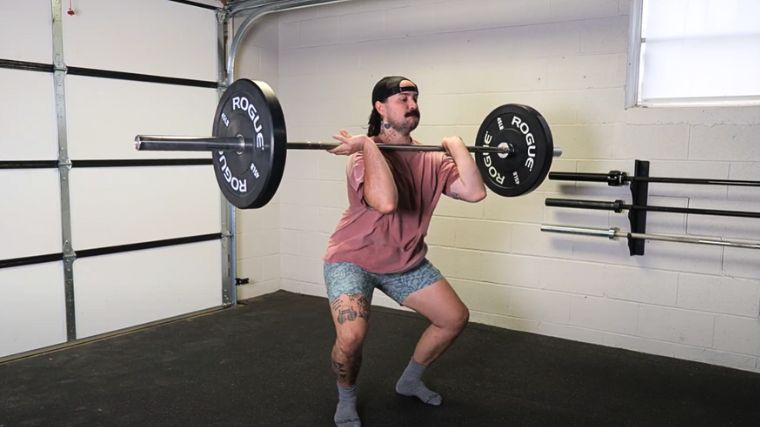
[Read More: How to Do the Clean for Explosive Power, Muscle Growth, and Much More]
You can also use this as part of a complex for lifters who may have issues bridging the gap between full cleans and power cleans.
Muscles Worked by the Power Clean
The power clean is a complex movement that primarily works the posterior chain; however, it is still highly stressful to the legs, back, and core stabilizers. Here are the main muscle groups you’ll use when you do power cleans:
Hamstrings and Glutes
The hamstrings and glutes are most active during the first phase of the movement when you lower the barbell to your knees. By doing this, you’re accumulating tension in your hamstrings and glutes — like a spring — and then releasing that tension to drive the barbell up.
Quadriceps
The quads aren’t that engaged during this lift, but they are under load when you complete the partial squat phase of this lift at the apex of the exercise.
Back and Traps
Your back and traps are really engaged when you pull the barbell up to the front rack position. They’re also active as you stabilize the bar in the front rack position, as those muscles prevent you from falling forward with the weight.
Common Mistakes While Doing the Power Clean
The power clean has a lot going on. Mastering each aspect of the technique will make all the difference when it comes time to load up your barbell. These are some of the most common errors people commit when trying to do cleans; steer clear of them.
Using Your Arms
Although your arms physically hold onto the barbell, the power clean is not an upper-body pulling exercise. Your arms serve only to flip the bar into the front rack position and hold it there. Think of them as loose ropes while you’re pulling. Bending your arms or holding tension in that area will affect your ability to generate force with your legs.
Pulling Early
In weightlifting, an “early” pull occurs when you try to extend your lower body and “jump” before the bar is in the proper place. For most folks, that correct spot is when the bar reaches mid-to-high thigh.
[Read More: Are You Making these Five Clean & Jerk Mistakes? Here’s How to Fix Them]
If you try to extend before the bar gets there, you’ll sap yourself of your power and potentially send the bar flying forward rather than upward.
Deadlifting the Weight
The power clean is not a deadlift. Don’t try to set up for it the same way you would for your conventional or Romanian deadlifts. When you set up to do power cleans, allow your hips to sit a bit lower than usual, and intentionally let your knees come forward in front of the barbell. This position will cause you to rely more on the strength of your quads instead of just your posterior chain.
FAQs
Yes. Power cleans are a good beginner movement as it doesn’t require the beginner to perform a full squat. That said, sometimes the hang power clean or block power clean is a better option for beginners as they do not have to perform the full pull from the floor, simplifying the lift. Nonetheless, you can have them also perform power cleans + front squats to help them transition to full squats.
The power clean has the lifter secure the weight in the front rack while in a partial squat, whereas the full clean allows the lift to transition into the full-depth squat.
Here’s a quick roadmap for choosing your set and rep schemes.
To improve your technique: Do three to five sets of three to five reps with 50 to 70 percent of your 1-rep max.
For more power: Perform four to six sets of two to three repetitions, using 65 to 80 percent of your 1RM.
For more strength: Do five to 10 sets of one to two reps with 80 percent or more of your 1RM.
References
- Faigenbaum AD, McFarland JE, Herman RE, Naclerio F, Ratamess NA, Kang J, Myer GD. Reliability of the one-repetition-maximum power clean test in adolescent athletes. J Strength Cond Res. 2012 Feb;26(2):432-7. doi: 10.1519/JSC.0b013e318220db2c. PMID: 22233786; PMCID: PMC3561668.
- Garhammer, John. A Review of Power Output Studies of Olympic and Powerlifting: Methodology, Performance Prediction, and Evaluation Tests. Journal of Strength and Conditioning Research 7(2):p 76-89, May 1993.
Featured Image: Riley Stefan
The post The Power Clean Exercise: How To, Variations, and Fix Common Mistakes appeared first on BarBend.

